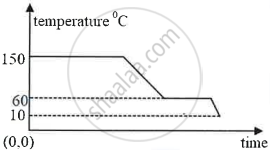Advertisements
Advertisements
Question
If there is no Heat loss to the surroundings, the heat released by the condensation of m1 g of steam at 100°C into water at 100°C can be used to convert m2 g of ice at 0°C into water at 0°C.
(i) Find:
(a) The heat lost by steam in terms of m1
(b) The heat gained by ice in terms of m2
(ii) Form a heat equation find the ratio of m2 : m1
Specific latent heat of vaporization of steam = 2268 kJ/kg
Specific latent heat of fusion of ice = 336 kJ/kg
Specific heat capacity of water = 4200 J/kg°C
Solution
(i)
(a) Heat lost by steam = mL + mst
= m1 × 10-3 × 2268 + m1 × 10-3 × 4.2 × 100
(b) Heat gained by ice in converting to water at 0°C
mL = m2 × 10-3 × 336 kJ
(ii) Heat lost by steam = Heat gained by ice
(m1 × 10-3 × 2268 + m1 × 10-3 × 4.2 × 100) = m2 × 10-3 × 336
Or m1 × 10-3 (2268 + 420) = m2 × 10-3 × 336
∴ `"m"_2/"m"_1 = (10^-3 xx 2688)/(10^-3 xx 336) = 8/1`
∴ The ratio m2 : m1 = 8 : 1
APPEARS IN
RELATED QUESTIONS
State two characteristics of a good thermion emitter.
What do you understand by the term latent heat?
Write the approximate value of specific latent heat of ice.
A refrigerator converts 100g of water at 20℃ to ice at – 10℃ in 73.5 min. Calculate the average rate of heat extraction in watt. The specific heat capacity of water is 4.2 J kg-1 K-1, specific latent heat of ice is 336 J g-1 and the specific heat capacity of ice is 2.1 J kg-1 K-1.
Calculate the total amount of heat energy required to convert 100 g of ice at −10℃ completely into water at 100℃. Specific heat capacity of ice = 2.1 J g-1 K-1, specific heat capacity of water = 4.2 J g-1K-1, specific latent heat of ice = 336 J g-1.
Explain the following temperature vs time graph.

Define the following terms:
(i) Specific latent heat,
(ii) Specific latent heat of fusion.
A substance changes from its solid state to the liquid state when heat is supplied to it. What name is given to heat absorbed by the substance.
Name two factors on which the heat absorbed or given out by a body depends.
Explain why water is used in hot water bottles for fomentation and also as a universal coolant.
Why water get cooled in a ‘Surahi’ in hot season?
Define the term ‘specific latent heat of fusion’ of a substance.
Explain, why no tracks are left on the ice during ice skating?
Steam at 100°C is passed over 1000 g of ice at 0°C. After some time, 600 g of ice at 0°C is left and 450 g of water at 0°C is formed. Calculate the specific latent heat of vaporization of steam (Given: specific heat capacity of water = 4200 J/kg°C, specific latent heat of fusion of ice = 336,000 J/kg.)
Find the odd one out and give its explanation.
Write the name.
The phase in which solid substances are converted into liquid.
During reheating, ice is converted to water at a temperature of 0 °C.
Who introduced the term latent heat?
Calculate the amount of heat required to convert 200g of ice at 0°C into the water at 0°C Specific latent heat of fusion of ice = 336 Jg-1
The diagram below shows a cooling curve for a substance:

- State the temperatures at which the substance condenses.
- The temperature range in which the substance is in liquid state.
- Why do we prefer ice to ice-cold water for cooling a drink?
